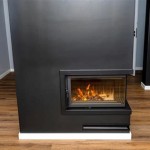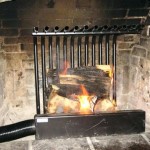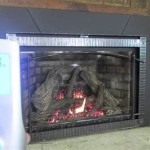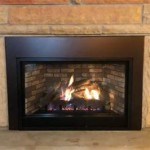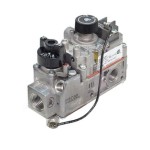Custom Gas Fireplace Inserts: A Guide to Design, Functionality, and Installation
Gas fireplace inserts offer a convenient and efficient way to revitalize existing masonry or prefabricated fireplaces. Instead of relying on wood, these inserts utilize natural gas or propane to generate heat, offering a cleaner and more controllable alternative. Custom gas fireplace inserts take this functionality a step further, allowing homeowners to precisely tailor the unit's appearance and performance to complement their specific needs and aesthetic preferences.
This article explores the various aspects of custom gas fireplace inserts, including their benefits, key features, design considerations, and installation processes. Understanding these elements is crucial for making informed decisions when selecting a custom insert for any home.
A fireplace insert is designed to fit inside an existing fireplace opening, transforming it into a more efficient heating source. They consist typically of a firebox, burner system, glass front, and a flue liner that vents exhaust gases safely outside. Unlike traditional fireplaces that lose a significant amount of heat up the chimney, gas inserts are designed to circulate heat into the room, providing a more comfortable and cost-effective heating solution.
The "custom" aspect comes into play when homeowners choose to personalize various elements of the insert, such as the firebox lining, log set, surround design, and control options. This level of customization ensures that the fireplace insert not only functions efficiently but also seamlessly integrates with the room's decor and overall design scheme.
Benefits of Choosing a Custom Gas Fireplace Insert
Custom gas fireplace inserts provide several advantages compared to standard, off-the-shelf models. These benefits extend beyond mere aesthetics, impacting energy efficiency, convenience, and overall home value.
One primary benefit is the enhanced heating efficiency. Standard fireplaces can draw air from the room, contributing to heat loss. Gas inserts, particularly those that are custom-fitted and properly sealed, minimize this effect. They often feature sealed combustion systems, drawing combustion air from outside the home and venting exhaust gases directly through a flue liner. This results in more consistent and even heating throughout the room, reducing reliance on central heating and lowering energy bills.
Another key advantage is the convenience they provide. Unlike wood-burning fireplaces, gas inserts eliminate the need for storing, chopping, and hauling wood. With a simple push of a button or a remote control, the fireplace comes to life, providing instant heat and ambiance. This ease of use makes gas inserts a practical choice for busy homeowners who want to enjoy the warmth and aesthetic appeal of a fireplace without the hassle of traditional wood-burning options.
Furthermore, custom gas fireplace inserts offer unparalleled aesthetic flexibility. Homeowners can select from a wide range of design options to create a fireplace that perfectly matches their personal style. From traditional log sets and brick liners to contemporary glass media and sleek metal surrounds, the possibilities are virtually endless. This ability to customize the appearance ensures that the fireplace becomes a focal point of the room, enhancing its overall beauty and value.
Safety is also improved with gas inserts. The sealed combustion system reduces the risk of carbon monoxide poisoning and chimney fires because the products of combustion are safely vented outside. Many models also include safety features like automatic shut-off valves and flame sensors, providing peace of mind for homeowners and their families.
Key Features and Design Considerations
When selecting a custom gas fireplace insert, several key features and design considerations warrant careful evaluation. These elements influence the insert's performance, aesthetics, and overall suitability for the specific fireplace and room.
The burner system is one of the most important features. Different burner types, such as ribbon burners, pan burners, and multi-burner systems, offer varying flame patterns and heat outputs. Ribbon burners create a long, linear flame that is often preferred for modern designs, while pan burners produce a more traditional, flickering flame. Multi-burner systems allow for greater control over the flame height and heat intensity.
The firebox lining also plays a significant role in the insert's appearance and heat retention. Common lining materials include brick, ceramic, and metal. Brick liners offer a classic, traditional look, while ceramic liners provide a smooth, contemporary finish. Metal liners, often made from stainless steel or black enamel, reflect heat back into the room, enhancing efficiency. The choice of lining material should complement the overall design scheme of the room and the desired aesthetic of the fireplace.
The log set or media is another crucial design element. Log sets are available in a wide variety of styles, from realistic representations of various wood species to more stylized, artistic designs. Glass media, such as fire glass or decorative stones, provides a modern, minimalist look. The choice of log set or media should reflect the homeowner's personal taste and the overall design of the room.
The surround, which is the frame that surrounds the fireplace opening, provides another opportunity for customization. Surrounds can be made from a variety of materials, including wood, stone, metal, and tile. The style and finish of the surround should complement the firebox lining, log set, and overall design of the room.
Control options are also important to consider. Some gas inserts come with basic on/off switches, while others offer more advanced features such as remote controls, thermostats, and programmable timers. Remote controls allow for convenient operation from anywhere in the room, while thermostats maintain a consistent temperature. Programmable timers allow homeowners to set the fireplace to turn on and off at specific times, saving energy and enhancing convenience.
Installation and Safety Requirements
Proper installation is essential for ensuring the safe and efficient operation of a custom gas fireplace insert. It is strongly recommended that installation be performed by a qualified and licensed professional who is familiar with local building codes and safety regulations.
The first step in the installation process is to prepare the existing fireplace. This may involve cleaning the firebox, inspecting the chimney, and ensuring that the fireplace opening is of the correct size and shape to accommodate the insert. In some cases, modifications to the fireplace opening may be necessary.
The next step is to install a flue liner. A flue liner is a metal pipe that runs from the fireplace insert to the top of the chimney. It vents exhaust gases safely outside and prevents them from leaking into the home. The flue liner must be of the correct size and material for the specific gas insert and must be installed according to manufacturer's instructions and local codes. Many liners are flexible for simplified installation within existing masonry.
Once the flue liner is installed, the gas insert can be placed into the fireplace opening. The insert must be properly secured and sealed to prevent air leaks. The gas line must be connected to the insert according to local codes and manufacturer's instructions. It is critical to ensure there are no leaks in the gas line.
After the insert is installed, it should be tested to ensure that it is functioning properly. This includes checking the flame pattern, verifying the heat output, and inspecting for any gas leaks. A qualified professional can perform these tests and make any necessary adjustments.
Safety is paramount during the installation process. It is important to follow all manufacturer's instructions and local codes. A carbon monoxide detector should be installed in the home to provide an early warning of any potential carbon monoxide leaks. Regular maintenance, including cleaning and inspection, is also crucial for ensuring the continued safe and efficient operation of the gas fireplace insert.
Obtaining the necessary permits prior to installation is also a critical step. Local building codes often require permits for gas appliance installations, and failing to obtain these permits can result in fines or other penalties. A qualified installer can assist with the permitting process.
In conclusion, a custom gas fireplace insert can be a valuable addition to any home, providing efficient heating, aesthetic appeal, and enhanced convenience. By carefully considering the key features, design options, and installation requirements, homeowners can select an insert that perfectly meets their needs and enhances their living space. Emphasis on professional installation and adherence to safety regulations ensures a safe and enjoyable experience for years to come.

Fireplace Xtrordinair Gas Inserts Custom Hearth Fireplaces And Stoves

Gas Fireplaces Inserts And Stoves Heat Ambiance At The Touch Of A On

Chaska 25 Gas Fireplace Insert With Remote Small Log

Fireplaces Smith May Inc

Fireplace Insert Guide Fireplaces Direct Learning Center

Fireplace Insert Installation Wood Inserts Gas Pellet And Electric

Custom Built Fireplace Surround Install A New Mantel Hearth

Gas Insert Installed In Arched Masonry Fireplace Custom Fireside

Contemporary Gas Fireplaces The Fireplace Company Aspen Snowmass Carbondale Basalt Glenwood Springs No Name New Castle Silt Crested E Gunnison County And

Heat Glo Foundation Bay Custom Gas Fireplace Energy House
Related Posts



